FINDING EXPONENTIAL FUNCTION FROM TABLE
Subscribe to our ▶️ YouTube channel 🔴 for the latest videos, updates, and tips.
We can write the exponential function in the form
y = a bx
Here a is the initial value and b is the constant multiplier.
Exponential growth :
The value of depended variable grows as the value of the independent variable increases.
If b > 1 then the starting amount a is multiplied by the number greater than 1 and will increase as x increases.
Exponential decay :
The value of depended variable decays as the value of the independent variable increases.
If 0 < b < 1 then the starting amount a is multiplied by the number less than 1 and will decrease as x increases.
How to equation of exponential function from the table ?
In the table, look for the ratio of successive values of the dependent variable, if these ratios are constant, then the function is an exponential function. The constant ratio is the value of b.
The table contains some points on the graph of an exponential function. Based on the table, what function represents the relationship
Problem 1 :
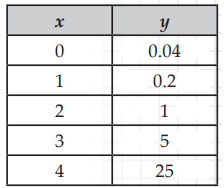
Solution :
Initial value (a) = 0.04
Check if the table represents exponential function or not :
0.2/0.04 ==> 5
1/0.2 ==> 5
5/1 ==> 5
25/5 ==> 5
Since common ratio is same, it is exponential function.
Here,
b = 5 > 1 (exponential growth)
y = 0.04(5)x
Problem 2 :
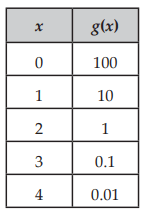
Solution :
Initial value (a) = 100
Check if the table represents exponential function or not :
10/100 ==> 1/10
1/10 ==> 1/10
0.1/1 ==> 1/10
0.01/0.1 ==> 1/10
Since common ratio is same, it is exponential function.
Here,
b = 0< 1/10 < 1 (exponential decay)
g(x) = 100(1/10)x
Problem 3 :
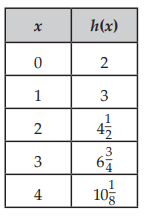
Solution :
Initial value (a) = 2
Check if the table represents exponential function or not :
3/2 ==> 1.5
(9/2)/3 ==> 1.5
(27/4) / (9/2) ==> 1.5
(81/4) / (27/4) ==> 1.5
Since common ratio is same, it is exponential function.
Here,
b = 1.5 > 1 (exponential growth)
h(x) = 2(1.5)x
Problem 4 :
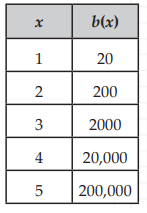
Solution :
Initial value is not given, when x = 0, there is no value for b(x).
Check if the table represents exponential function or not :
200/20 ==> 10
2000/200 ==> 10
20000/2000 ==> 10
Since common ratio is same, it is exponential function.
Here,
b = 10 > 1 (exponential growth)
b(x) = a(10)x ----(1)
Applying the point (1, 20) in the function, we get
20 = a(10)1
a = 20/10
a = 2
Applying the value of a in (1), we get
b(x) = 2(10)x
Problem 5 :
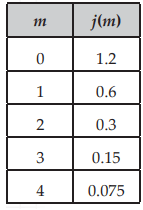
Solution :
Initial value a = 1.2
Check if the table represents exponential function or not :
0.6/1.2 ==> 0.5
0.3/0.6 ==> 0.5
0.15/0.3 ==> 0.5
0.075/0.15 ==> 0.5
Since common ratio is same, it is exponential function.
Here,
b = 0.5, 0 < b < 1 (exponential decay)
b(x) = 1.2(0.5)x
Problem 6 :

Solution :
Initial value is not given, when x = 0, y = 4
Check if the table represents exponential function or not :
1/(1/2) ==> 2
2/1 ==> 2
16/8 ==> 2
Since common ratio is same, it is exponential function.
Here,
b = 2 > 1 (exponential growth)
b(x) = 4(2)x ----(1)
Problem 7 :
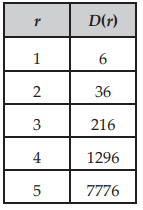
Solution :
Initial value is not given, when x = 0, there is no value for D(r).
Check if the table represents exponential function or not :
36/6 ==> 6
216/36 ==> 6
1296/216 ==> 6
7776/1296 ==> 6
Since common ratio is same, it is exponential function.
Here,
b = 6 > 1 (exponential growth)
b(x) = a(10)x ----(1)
Applying the point (1, 6) in the function, we get
6 = a(6)1
a = 6/6
a = 1
Applying the value of a in (1), we get
D(r) = 1(6)x
Problem 8 :
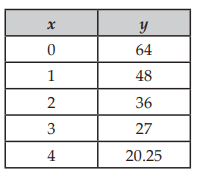
Solution :
Initial value is a = 64.
Check if the table represents exponential function or not :
48/64 ==> 0.75
36/48 ==> 0.75
27/36 ==> 0.75
20.25/27 ==> 0.75
Since common ratio is same, it is exponential function.
Here,
b = 0.75, 0 < b < 1 (exponential decay)
y = 64(0.75)x
Subscribe to our ▶️ YouTube channel 🔴 for the latest videos, updates, and tips.
Recent Articles
-
Finding Range of Values Inequality Problems
May 21, 24 08:51 PM
Finding Range of Values Inequality Problems -
Solving Two Step Inequality Word Problems
May 21, 24 08:51 AM
Solving Two Step Inequality Word Problems -
Exponential Function Context and Data Modeling
May 20, 24 10:45 PM
Exponential Function Context and Data Modeling